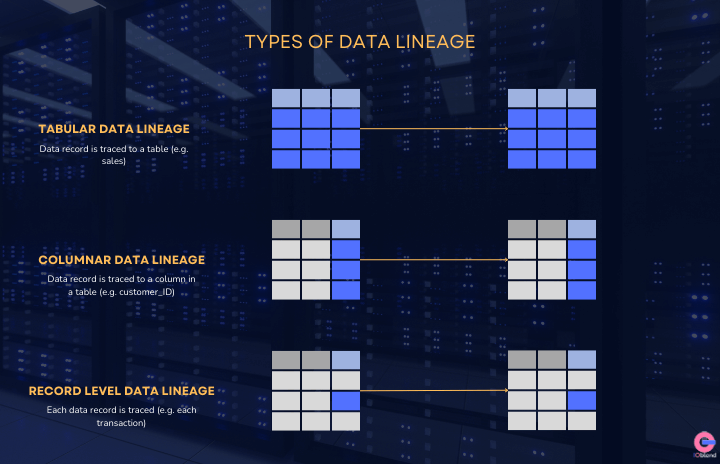Data Lineage: A Data Governance Must Have
The significance of data in today’s digital-driven landscape cannot be overstated. However, the value isn’t just in having vast amounts of data, but in understanding its journey from origin to endpoint. This brings us to the concept of data lineage, a vital component of data governance and management.
Why is Data Lineage Important?
Data lineage provides a comprehensive trace of data’s journey throughout its lifecycle – from its initial source, through various transformations and, finally, to its destination. The benefits include:
Data Integrity: Ensuring the sanctity of the data feeding into systems is paramount. Anomalies or inconsistencies can produce misleading results, affecting business decisions.
Enhanced Data Trustworthiness: Ensuring stakeholders trust the data-driven insights.
Fault Identification & Recovery: If systems go awry and corrupt data, knowing its lineage can expedite identifying the root cause and restoring it. Without lineage, pinning down such glitches can be like searching for a needle in a haystack.
Auditing & Compliance: From an auditing perspective, data lineage offers a clear trace of how data evolves and ensures that it complies with regulatory mandates.
Efficient Data Governance: Establish better data management and usage protocols.
Data Lineage is paramount in various industries:
Banking: A transaction data may originate from a mobile app, undergo validation checks, get processed in a central system, and finally reflect in a customer’s account statement. Tracing this path ensures transactional accuracy and integrity.
Healthcare: Patient data might come from various devices and systems, undergo processing for diagnosis, and be stored in health records. Mapping this journey ensures data consistency and patient privacy.
Aviation: It is crucial to ensure the accuracy of data related to flight schedules, aircraft maintenance, and passenger information. Data lineage is used to trace the history of this data to identify any potential errors or inconsistencies.
There are several ways to capture data lineage
Manual Documentation: Traditional method involving hand-drawn diagrams or spreadsheets.
Automated Data Lineage Tools: Use of specialized software to automatically discover, capture, and visualize data lineage. These tools then offer varying degrees of granularity:
- DAG, or visual, where you can see how your data flows through each stage of iterations
- Tabular, where you can trace the origins at a table level
- Columnar, that allows you to trace data within a column in a table (these are now being used in data lakes and warehouses)
- Record level, the most granular lineage, where you can trace the origin of each individual record (particularly important in audits and real time applications)

Unfortunately, as we’ve noticed at IOblend, many organisations often overlook data lineage, largely due to the rush to deploy new systems and data products. The initial urgency to launch often places higher priority on delivery than on the quality of data that fuels these systems. But such short-term vision inevitably results in long-term data challenges, impacting security, reliability, and decision-making.
The reason data lineage is often pushed back is due to the complexity of implementation. Crafting data lineage manually across all dataflows is massive, especially with live data streaming. The market offers data lineage tools, but the key is to find one harmonizing with your data landscape and providing desired granularity. Ideally, you want data lineage as part of your data pipeline tools, so you can monitor your data from source to sink in one go.
IOblend’s Approach to Data Lineage Automation
Since we have encountered data lineage issues on more than one occasion, we made data lineage an integral part of our solution. We do DataOps, and data lineage is DataOps. At IOblend, we made sure that the most granular data lineage is available to you ‘out-of-the-box’. It starts at record level with the raw data and maps the transformations all the way to the end target.
In addition to the DAG, we also tag every record at all stages of the data pipeline to monitor the “what”, “who”, “when” and “where”, making the full audit of the data quick and hassle-free. IOblend maintains “state” throughout, so it is always aware of any changes instantaneously and applies appropriate actions. Just visually design your dataflow and data lineage is applied automatically, every time. There is no additional requirement to setup or code data lineage policies or purchase additional tools.
Data lineage, though unfortunately often overlooked, is undeniably the backbone of reliable data systems. As businesses transition into data-driven entities, the significance of lineage becomes even more pronounced. With automated platforms like IOblend, the hope is that more organizations will adopt data lineage more widely and ensure a secure and transparent data future.
Download a FREE Developer Edition and see for yourself how simple data lineage can be to implement.
In the realm of real-time analytics, managing data lineage is essential to ensure data integrity and trustworthiness. Data lineage, a critical aspect of data governance, provides a trace of data’s journey throughout its lifecycle, from the source to various transformations and its final destination. This traceability is vital for several reasons: it ensures the sanctity of data feeding into systems, aids in fault identification and recovery, supports auditing and compliance, and establishes efficient data governance protocols. Different industries, such as banking, healthcare, and aviation, rely on data lineage to ensure transactional accuracy, data consistency, and patient privacy. While manual documentation has traditionally been used, automated data lineage tools now offer various degrees of granularity, including visual (DAG), tabular, columnar, and record-level lineage, essential for audits and real-time applications. However, the complexity of implementation can often lead to its oversight. IOblend addresses this challenge by integrating data lineage into its DataOps solution, offering out-of-the-box granular data lineage that tracks every record through data pipelines. This automation ensures a quick and hassle-free audit of data, maintaining state throughout the dataflow.

ERP Cloud Migration With Live Data Sync
Seamless Core System Migration: The Move of Large-Scale Banking and Insurance ERP Data to a Modern Cloud Architecture ⛅ Did you know that core system migrations in large financial institutions, which typically rely on manual data mapping and validation, often require parallel runs lasting over 18 months? The Core Challenge The migration of multi-terabyte ERP and

Legacy ERP Integration to Modern Data Fabric
Warehouse Automation Efficiency: Migrating and Integrating Legacy ERP Data into a Modern Big Data Ecosystem 📦 Did you know? Analysts estimate that warehouses leveraging robust, real-time data integration see inventory accuracy improvements of up to 99%. The Convergence of WMS and Big Data Data professionals in logistics face a profound challenge extracting mission-critical operational data such

Dynamic Pricing with Agentic AI
The Agentic Edge: Real-Time Dynamic Pricing through AI-Driven Cloud Data Integration 📊 Did You Know? The most sophisticated dynamic pricing systems can process and react to market signals in under 100 milliseconds. The Evolution of Value Optimisation Dynamic Pricing and Revenue Management (DPRM) is a complex computational science. At its core, DPRM aims to sell the right

Smarter Quality Control with Cloud + IOblend
Quality Control Reimagined: Cloud, the Fusion of Legacy Data and Vision AI 🏭 Did You Know? Over 80% of manufacturing and quality data is considered ‘dark’ inaccessible or siloed within legacy on-premises systems, dramatically hindering the deployment of real-time, predictive Quality Control (QC) systems like Vision AI. Quality Control Reimagined The core concept of modern quality

Predictive Aircraft Maintenance with Agentic AI
Predictive Aircraft Maintenance: Consolidating Data from Engine Sensors and MRO Systems 🛫 Did you know that leveraging Big Data analytics for predictive aircraft maintenance can reduce unscheduled aircraft downtime by up to 30% Predictive Maintenance: The Core Concept Predictive Maintenance (PdM) in aviation is the strategic shift from a time-based or reactive approach to an ‘as-needed’ model,

Digital Twin Evolution: Big Data & AI with
The Industrial Renaissance: How Agentic AI and Big Data Power the Self-Optimising Digital Twin 🏭 Did You Know? A fully realised industrial Digital Twin, underpinned by real-time data, has been proven to reduce unplanned production downtime by up to 20%. The Digital Twin Evolution The Digital Twin is a sophisticated, living, virtual counterpart of a physical production system. It

